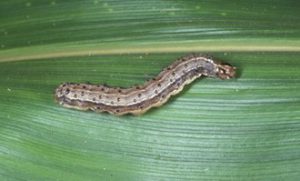Did you know that Florida is the winter strawberry capital of the world? It’s true! In fact, Florida ranks second only to California as the nation’s largest producer of strawberries. Nearly 10,500 acres in Florida are currently dedicated to strawberry production, generating upward of $350 million dollars annually.

Owing to our relatively mild winters, planting dates typically range from early September to mid to late November, with strawberries continuing to flower and produce fruit through April and May. As with many cultivated garden plants, pressure and damage from insects and pathogens will evolve throughout the growing season.

Early on, be sure to look for defoliated leaves with holes or missing margins, as this may be an indicator of fall (Spodoptera frugiperda) or southern (Spodoptera eridania) army worms. These caterpillars are typically found feeding on leaflets and young flower tissue and may potentially leave behind small fecal droppings as they feed.

As the season progresses, check for aphids and flower thrips that can damage leaves and developing fruit. Two common aphids frequently found on strawberries here in Florida are the strawberry root aphid (Aphis forebsi) and the cotton or melon aphid (Aphis gossypii). Aphids damage plants while sap feeding with their straw-like mouth parts, causing leaf wrinkling over time and reducing the plants ability to photosynthesize. They also excrete a sticky, sugary substance known as “honeydew” which can attract other pests and encourage pathogens, such as sooty mold. Similarly, while feeding on flower blossoms, Florida flower thrips (Frankliniella bispinosa), can also cause damage to flowers and fruit over time.

One of the most significant pests of strawberries in Florida are spider mites, such as the two-spotted spider mite (Tetranychus urticae). Damage from these pests is typically presented as chlorotic, pin-point stippling or bronzing of the leaves. These mites rapidly migrate around the plant through the production of their webbing. Keep an eye out for these pests starting in early December, making sure to check the underside of leaves.
In general, it is important to start with healthy strawberry transplants or seeds, taking care to purchase your plant material from a reputable nursery or garden center.
For more information on growing your own strawberries, check out Growing Strawberries in the Florida Home Garden.
An excellent source for more information on seasonal planting dates, pests and pathogens, and helpful pest management suggestions check out the USDA-NIFA Crop Profile Sheet., UF/IFAS Strawberry Pest Management EDIS site, and the UF/IFAS Strawberry IPM EDIS Document.
 0
0
